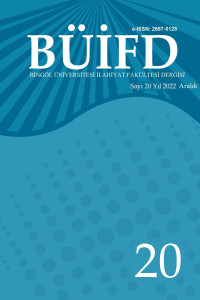Öz
The Quran always shows its existence with its linguistic aspects such as insensibility, rhetoric and rhetoric. It reveals its difference with the artistic use of words and the wool of meaning attributed to them. The use of hyperbole originating from ism-i fâil is one of them. Very different exaggeration patterns are used in the Quran. Here, a general evaluation will be made on the فَعَّال pattern, which is one of the many verses in the science of consumption. The main motive for choosing this pattern is to show the relationship between letter highness and meaning density. While the exaggeration patterns, which are generally quasi and semâi, support the same methodology, the use of فَعَّال has added intensity to the meaning of other patterns, which led us to this study. Because linguists have clearly stated that the increase in the number of letters serves the exaggeration in meaning. It is a striking use in this cigarette mostly in Esmâu'l Hüsnâ and it is seen that it mostly takes place at the end of the verses.
This pattern will be discussed in terms of dimensions such as mufra, plural, praise, satire, adjective, seasonal, feminism and warrant. Efforts will be made to understand this pattern, which adds an important beauty to words with its description and introduction. Instead of listing the exaggeration and explaining them one by one, like the existing studies, the shaping of a mold in different dimensions in the Quran will be processed.
Anahtar Kelimeler
Kaynakça
- Revabide, Muhammed Emin, Siyeği’l Mübalağati’l Kıyâsîye İttihadu’l Mebna ve’l Ma’na, Mecelletu’l-Urduniyye el-Luğatu’l Arabiyye ve Adâbuha, 2/3, 2006.
- el-Mâverdî, Ebü’l-Hasen Alî b. Muhammed b. Habîb el-Basrî en-Nüket ve’l-ʿuyûn tefsîru’l Mâverdî, Beyrut: Daru’l-Kutubi’l-İlmiyye, ts.
- ez- Zemahşerî, Ebu’l-Kāsım Cârullah Mahmûd b. Ömer b. Muhammed el-Hārizmî, Keşşâf ‘an hakā’ikı ğavâmidı’t-tenzîl ve ‘uyûni’l-ekāvîl fî vucûhi’t-te’vîl, çev. Komisyon, İstanbul: Türkiye Yazma Eserler Kurumu Başkanlığı Yayınları, 2016.
Öz
Kur’ân, îcâz, i’câz ve belâgat gibi dilsel yönleriyle her zaman varlığını göstermektedir. Gerek kelimelerin sanatlı kullanımı ve gerekse de onlara yüklenen anlam yünü ile farklılığını ortaya koymaktadır. Kur’ân’da çok farklı mübalağa kalıbı kullanılmıştır. İsm-i fâil menşeli mübalağa kalıplarının kullanımı da bunlardan bir tanesidir. Burada sarf ilminde mazbut olan birçok vezinden biri olan فَعَّال kalıbı üzerinde genel bir değerlendirilmeye tabi tutulmaktadır. Bu kalıbı tercih etmedeki temel saik, harf ziyadeliği ile anlam yoğunluğu ilişkisini göstermektir. Zira dilbilimciler harf adedindeki artışın manadaki mübalağaya hizmet ettiğini açıkça bildirmişlerdir. Genel olarak kıyâsî ve semâi olan mübalağa kalıpları aynı metodolojiyi desteklerken فَعَّال kullanımının diğer kalıplara göre telaffuza bile farklı bir yoğunluk kattığına lisanın zevki şahittir. Bu sigada çoğunlukla da ayet sonlarında yer alan Esmâu’l Hüsnâ’da dikkat çeken bir kullanım da görülmektedir. Çalışmada bu kalıbın müfred, çoğul, övgü, yergi, sıfat, mevsuf, müenneslik ve müzekkerlik gibi boyutları ele alınmaktadır. Betimleme ve tanımlama açısından kelimelere önemli bir ahenk katan bu kalıbın örneklendirmeleri de yapılmaktadır. Mevcut yapılan çalışmalar gibi mübalağa sigalarını sıralayıp birer birer açıklamak yerine bu kalıbın Kur’ân’da farklı boyuttaki şekillenişi işlenmektedir. Kur’an defalarca taranmak suretiyle kalıpların tespitinden sonra genel bir değerlendirme yapılmaktadır.
Anahtar Kelimeler
Kaynakça
- Revabide, Muhammed Emin, Siyeği’l Mübalağati’l Kıyâsîye İttihadu’l Mebna ve’l Ma’na, Mecelletu’l-Urduniyye el-Luğatu’l Arabiyye ve Adâbuha, 2/3, 2006.
- el-Mâverdî, Ebü’l-Hasen Alî b. Muhammed b. Habîb el-Basrî en-Nüket ve’l-ʿuyûn tefsîru’l Mâverdî, Beyrut: Daru’l-Kutubi’l-İlmiyye, ts.
- ez- Zemahşerî, Ebu’l-Kāsım Cârullah Mahmûd b. Ömer b. Muhammed el-Hārizmî, Keşşâf ‘an hakā’ikı ğavâmidı’t-tenzîl ve ‘uyûni’l-ekāvîl fî vucûhi’t-te’vîl, çev. Komisyon, İstanbul: Türkiye Yazma Eserler Kurumu Başkanlığı Yayınları, 2016.
Ayrıntılar
| Birincil Dil | Türkçe |
|---|---|
| Konular | Dil Çalışmaları |
| Bölüm | Makaleler |
| Yazarlar | |
| Erken Görünüm Tarihi | 21 Aralık 2022 |
| Yayımlanma Tarihi | 25 Aralık 2022 |
| Gönderilme Tarihi | 11 Ekim 2022 |
| Kabul Tarihi | 3 Kasım 2022 |
| Yayımlandığı Sayı | Yıl 2022 Sayı: 20 |





